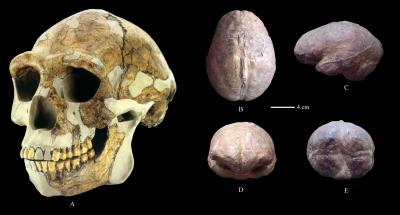
北京猿人复原头骨(A)与颅内模(B:顶面观;C:左侧面观;D:前面观;E:后面观)
人类左右脑半球在解剖结构和功能上具有高度的特异化,各自负责某些专门的活动,处理某些特定的刺激。由于脑的不对称性同人的认知能力,如语言、利手、音乐才能、学习能力等相关联,因此探讨人类进化过程中脑不对称性的演化过程一直以来受到人们的广泛关注。原始人类脑组织已经不复存在,脑演化研究的主要材料是颅内模,颅内模是从颅骨内表面得到的脑的外部形态,颅内模并不代表原始的脑的解剖结构,但因其保存有脑表面形态特征的信息,故而成为分析和探讨人类脑进化的重要研究材料。受研究材料和方法的限制,长期以来对原始人类脑不对称性的研究一般只局限于左右两半球向前、向后突出的程度,或者两半球左右宽度的对比上。
由中国科学院古脊椎动物与古人类研究所吴秀杰博士与潘雷撰写的《利用3D激光扫描技术分析周口店直立人脑的不对称性》一文,突破了传统研究方法的限制,利用3D激光扫描技术,对距今40-80万年前的周口店直立人脑的不对称性进行了研究,以探索人类进化过程中脑不对称性的变化,该文发表在《科学通报》2011年56卷第16期上。
周口店是在我国境内最早发现的猿人化石地点,自1927年以来,迄今已经发现了较完整的6具头盖骨化石,并人工复原出相应的6件脑模型。北京猿人的脑量的平均脑量值为1047 cm3,表面积平均值为556 cm2;现人代颅容量的平均颅容量值为1359 cm3,平均表面积为675 cm2。脑量的大小随地质时代变化存在增加的趋势,从周口店直立人到现代人,虽然脑的尺寸有增加的趋势,然而左右脑半球的比例没有发生显著的变化。在人类进化过程中脑的不对称性不是发生在脑量和表面积的大小尺寸上,而是发生在脑的内部的解剖结构中,这种解剖结构的变化与人脑一侧优势的演化过程可能有相关。在人类进化过程中,脑的解剖结构发生了变化,人类语言的产生、智力水平的提高、行为方式的进步可能与脑的这种解剖结构的变化有一定关系。本项研究使用的小型3D激光扫描仪(Model 2020i Desktop)能够获取物体表面的三维数据,精确度为0.79-1.05 mm,适合于人类头骨、颅内模等标本材料的研究。此款扫描仪体积小、重量轻,便于携带,能够捕捉标本表面的颜色信息,易于在电脑上清楚地勾画出标本表面的细微解剖特征,可以较为准确地对标本进行测量、分割和镜像复原,获得标本各个部位的体积、面积、形状等数据,是研究古人类脑演化的有利工具。该研究得到了国家自然科学基金(批准号: 40972017)、中国科学院知识创新工程重要方向项目(KZCX2-YW-159)、中国科学院战略性先导科技专项(XDA05130100)和科技部国际合作项目(2009DFB20580)资助。
生物探索推荐英文论文摘要:
DOI: 10.1007/s11434-011-4512-1
Identification of Zhoukoudian Homo erectus brain asymmetry using 3D laser scanning
Abstract:
Endocasts are important materials used for the study of human brain evolution, and allow examination of the external features of brain anatomy from the inside the cranium. Studies examining brain asymmetries in fossil hominids are usually limited to scoring of differences in hemisphere protrusion rostrally and caudally, or to comparing the width of the hemispheres. In the present study, using 3D laser scanning, we examined asymmetries of the hemisphere volumes and surface areas in the Zhoukoudain (ZKD) Homo erectus, dated to 0.4-0.8 Ma. Compared with modern endocasts, we found that the absolute hemisphere volumes and surface areas exhibited no significant asymmetries in the ZKD or in modern specimens. However, the relative hemisphere volumes against surface areas differed between the two groups. When comparing the relative sizes between the left and right hemispheres, the ZKD specimens exhibited a greater variation than in the modern humans; there were no differences in the two hemispheres in the ZKD specimens, while in the modern endocasts the left hemisphere was significantly greater than the right hemisphere. These data suggest that brain asymmetries originated from relative brain sizes rather than absolute brain volumes during human evolution. These anatomical changes are likely related to the origin of human brain lateralization.
Keywords: Zhoukoudian Homo erectus brain asymmetry hemisphere volume surface area brain evolution







